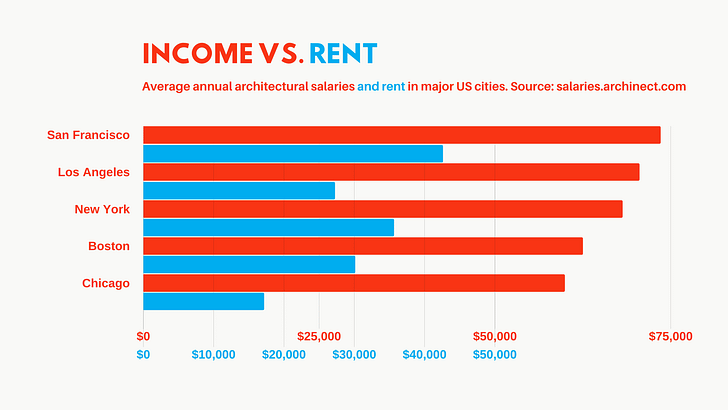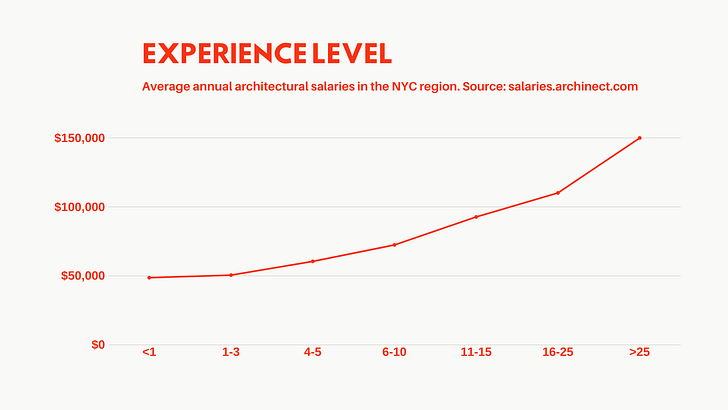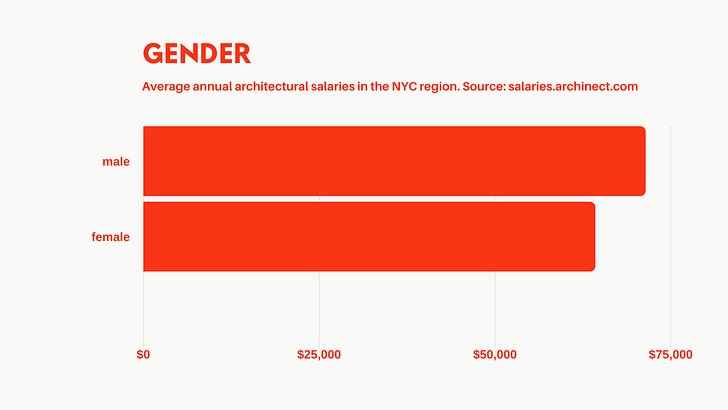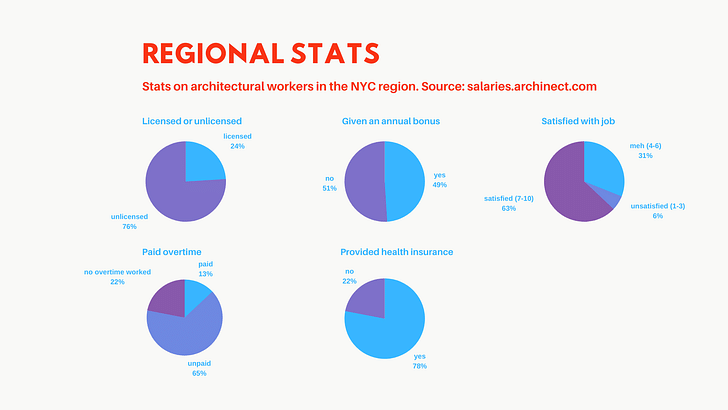

Defining what constitutes fair compensation represents perhaps one of the most contentious and divisive workplace issues roiling the architectural profession in the contemporary era. Whether it’s the spirited conversations surrounding unpaid and underpaid internship culture, the fight for equal pay regardless of gender, increasing pushes for unionization in architecture and aligned professions, or the popularization of the four-day workweek, the news is heavy with compensation discourse.
Not only that, but views on proper, fair, and equitable compensation vary widely by practice, firm type, and even among managers themselves, fueling uncertainty and secrecy that ultimately does little to help the average employee.
To help lend an element of transparency to these conversations, Archinect initiated the Architecture Salary Poll in 2013 to provide an anonymous forum for architectural workers to list their compensation figures. Over the years, we have collected thousands of submissions that provide valuable insight into salaries in the field. As part of a new series, we will be taking a look at regionally specific salary breakdowns to highlight trends, issues, and bright spots using data that we have collected via the salary poll.
As part of our Spotlight on NYC theme, our first month’s salary break down centers on New York City, the nation’s largest city and a global node for the Architecture Engineering and Construction industry.
How do average salaries for architectural workers compare overall and between regions? Using data collected through Architect’s Architecture Salary Poll, we can begin to tease out some of the differences that exist between the country’s top labor markets to shed light on the best places—financially speaking—to work in architecture.
First, the national average, according to 9935 results in the Salary Poll comes out to an average reported salary of $64,740 per year.

Now, let’s compare figures between New York City and similar regions.
In the case of New York, our poll data indicates that the average wage reported by 2171 respondents in the city was $68,137 per year, nearly 5% higher than the national average. By comparison, 870 architecture workers in Los Angeles and 742 workers in San Francisco reported wages between 3 and 8% higher than New York City, at $70,540 and $73,546 per year, respectively. Average reported wages for 339 workers in Boston and 441 workers in Chicago, on the other hand, fall below those in New York. In those cities, workers average $62,489 and $59,921 per year, respectively.

This break-down makes some sense when one considers certain cost of living factors, like average rents, and other affordability metrics. In New York City, for example, the average one-bedroom apartment runs $2,970 per month, according to Zumper.com. This outlandish figure, however, is only the second-highest in the country. The first? San Francisco, of course, where a one-bedroom runs $3,550 per month. So, although average wages reported in San Francisco are nearly 8% higher than in New York, rent there is actually 16% higher, according to these figures. Los Angeles, where average rents run $2,270 for a one-bedroom, may be a better bet for your pocketbook; Chicago, which doesn’t crack the top ten most expensive cities under this metric, has an average rent of $1,430 per month for a one-bedroom and may actually be the place to get the most bang for your buck despite its comparatively lower wages. Boston, on the other hand, seems like a bad bet both ways. Aside from lower wages, the city’s average rent falls just behind New York City at $2,510 per month for a one-bedroom unit.
Although average wages reported in San Francisco are nearly 8% higher than in New York, rent is actually 16% higher, according to these figures.
The numbers within the New York City market also present some interesting trends. Conventional wisdom might hold that working at a boutique architecture firm, where high-end clients, eye-popping aesthetics, and expensive finishes drive design, would be the best bet financially. Not so, according to the reported data. Instead, New York City’s corporate firms offer the best pay, where an average wage runs $72,799 per year, $5,724 higher than the figure for boutique firms. As one might expect, wages at “Starchitect” firms are not so great, either: $63,526 per year on average. The most meager? Being employed by individual architects, where workers make an average of $61,959 per year, according to the submitted responses.
Conventional wisdom might hold that working at a boutique architecture firm, where high-end clients, eye-popping aesthetics, and expensive finishes drive design, would be the best bet financially. Not so, according to the reported data.

Unpacking data for experience level shows that while starting wages may be somewhat low, they increase quickly as workers gain project and office experience. A case in point: The least-experienced workers with less than one year of work under their belts average $45,697 per year, according to the survey. Not to worry, however, as the figure increases by nearly $5,000 for the 1–3 year range and by another $10,000 for the 3–5 year range. Put another way, we can see wages increasing by more than 32% for younger workers after three or four years of work. Hang in there, because it gets better. Average compensation hits $72,443 per year for the 6–10 year range, nearly 20% higher than the previous bracket, with a sizable bump after that. Respondents with between 11 and 15 years of experience earn an average of $92,738.
The size of a practice also matters quite a bit for compensation. Mid-sized firms can take on larger and more complex projects than the smallest practices, for example, which might explain why wages are relatively high for 6–10, 11–15, and 16–50 employee firms, where salaries average $68,786, $63,277, and $66,067 per year, respectively. In these firms, workers will likely wear many hats, work across and even lead teams, and build value for lean practices through efficiency, skill, and experience.
The largest firms, however, where job titles are likely to be more solidly defined and wage tiers more regimented, show the highest average wages overall, with respondents of firms of 51 or more employees earning $69,736 per year.
The largest firms, however, where job titles are likely to be more solidly defined and wage tiers more regimented, show the highest average wages overall, with respondents of firms of 51 or more employees earning $69,736 per year. Architecture Salary Poll data notes, however, that the highest reported salaries come from sole practitioners, where the average reported wages are $73,455 per year. This relatively high wage can be due to a complex set of factors, including the fact that sole practitioners are positioned to best work on project types—custom residences, small- to medium-sized commercial, and other similarly bespoke designs—that are almost by definition, better-paid. The low overhead and direct relationship between work and compensation helps to ensure that these architects extract more value from their work than might be the case for larger firms that work on more collaborative and complex projects.

Gendered wage discrepancies persist across the architecture industry at all levels, both nationally and internationally. New York City is no exception, where men out-earn women by more than $7,000 on average. According to the collected responses, average salaries for workers who identify as male run $71,411 per year while those for female respondents fall short at $64,257 per year.
As a percentage, these figures show that according to Architecture Salary Poll respondents, female workers make 90% of what male workers do.
As a percentage, these figures show that according to Architecture Salary Poll respondents, female workers make 90% of what male workers do. Compare that to a 2016 survey by the United States Census Bureau reported by 60 Minutes showing wage equity gaps among engineering fields. According to that study, architects are faring slightly better in terms of pay equity than civil engineers, where female workers make 89% of what their male peers make. Mechanical engineers, on the other hand, have a better footing under this study, where women make 93% of what male mechanical engineers do. Better, that is, but still not equal.
A look at the data for different market focuses shows that highly specialized professionals enjoy higher wages, generally speaking. In New York City, where thousands of architects live and work, it is essential to carve a niche out for your practice. Often, specialization is achieved with greater experience, a bonus that not only allows firms to apply their expertises more efficiently, but often also allows them to bill clients at a higher rate than average. In tightly regulated sectors like industrial ($105,800), historic preservation ($93,942), transportation ($79,201), entertainment ($76,500), and forensics ($77,429), experienced designers are likely to bring added value to their projects due to expediency, code familiarity, and well developed relationships with specialized contractors, for example. Professionals with these specializations, according to the salary poll data, typically enjoy significantly higher wages than those in more generalized markets, like the retail ($68,070), commercial ($67,477), and cultural ($67,530) arenas. Not all specializations translate to higher wages, however, as sports ($53,000), residential ($65,131), civic ($66,454), and developer ($67,101) architectural workers see below-average wages in New York City.
Who doesn’t love bragging rights? Taking a look at the ten most-followed American architecture schools on Archinect (Columbia, Harvard, MIT, SCI-Arc, Yale, Pratt, UCLA, Cornell, U of Michigan, RISD, UC Berkeley, Rice, Syracuse, Princeton, UPenn, and Parsons), we see sharp diversions among reported wages. According to the Salary Poll data, graduates who hail from the Massachusetts Institute of Technology graduate program make the most, on average, at $87,667 per year, while graduates from Cornell make the least, $51,008 per year. The discrepancies could result from a variety of factors.
According to the Salary Poll data, graduates who hail from the Massachusetts Institute of Technology graduate program make the most, on average, at $87,667 per year, while graduates from Cornell make the least, $51,008 per year.
Here’s the breakdown by school ranked in terms of wages, from highest to lowest:

Some other interesting statistics that can be pulled out from the Salary Poll data follow.
In New York City, a whopping 76% of respondents are unlicensed.
65% of respondents reported that overtime worked at their respective firms went unpaid, with only 13% reporting getting paid for the overtime they put in. 22% reported working no overtime at all.
51% of respondents report getting an annual bonus.
78% are provided with some form of health insurance by their employers, though the Architecture Salary Poll does not ask specifically if health insurance is fully-covered or partially-subsidized.
63% of respondents rate their job satisfaction as 7 or higher (out of 10), while only 6% are unsatisfied (1–3).
The figures highlight salient facts about New York City, namely that it’s tough being an architect there. It takes over half a decade of experience for workers to reach regionally average wages, for example, a figure that is more difficult to reach for people who specialize in certain high-employment markets. In a city filled with rising stars, wages correspond somewhat inversely to ambitions, with steady, buttoned-up firms typically offering salaries much higher than type typical signature practices. Our data shows that where you go to school can play a significant role in future earnings, for a variety of reasons.
Antonio is a Los Angeles-based writer, designer, and preservationist. He completed the M.Arch I and Master of Preservation Studies programs at Tulane University in 2014, and earned a Bachelor of Arts in Architecture from Washington University in St. Louis in 2010. Antonio has written extensively ...
No Comments
Block this user
Are you sure you want to block this user and hide all related comments throughout the site?
Archinect
This is your first comment on Archinect. Your comment will be visible once approved.